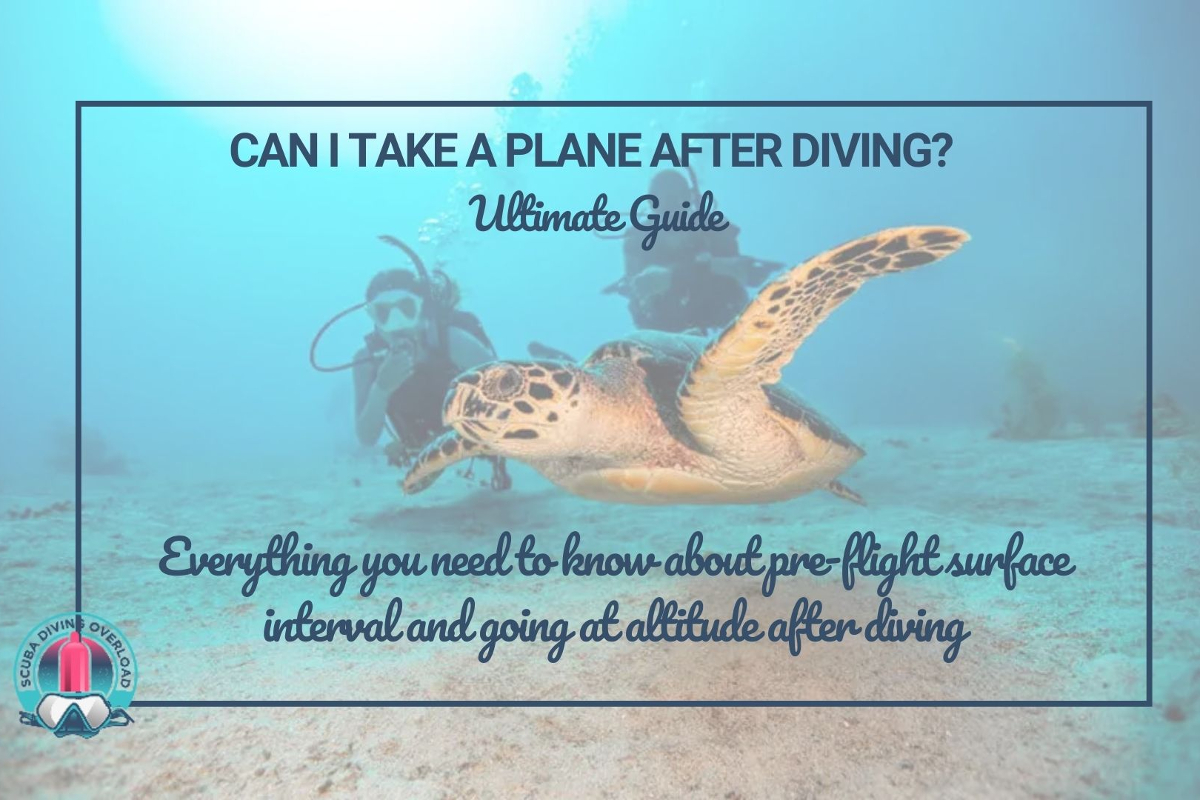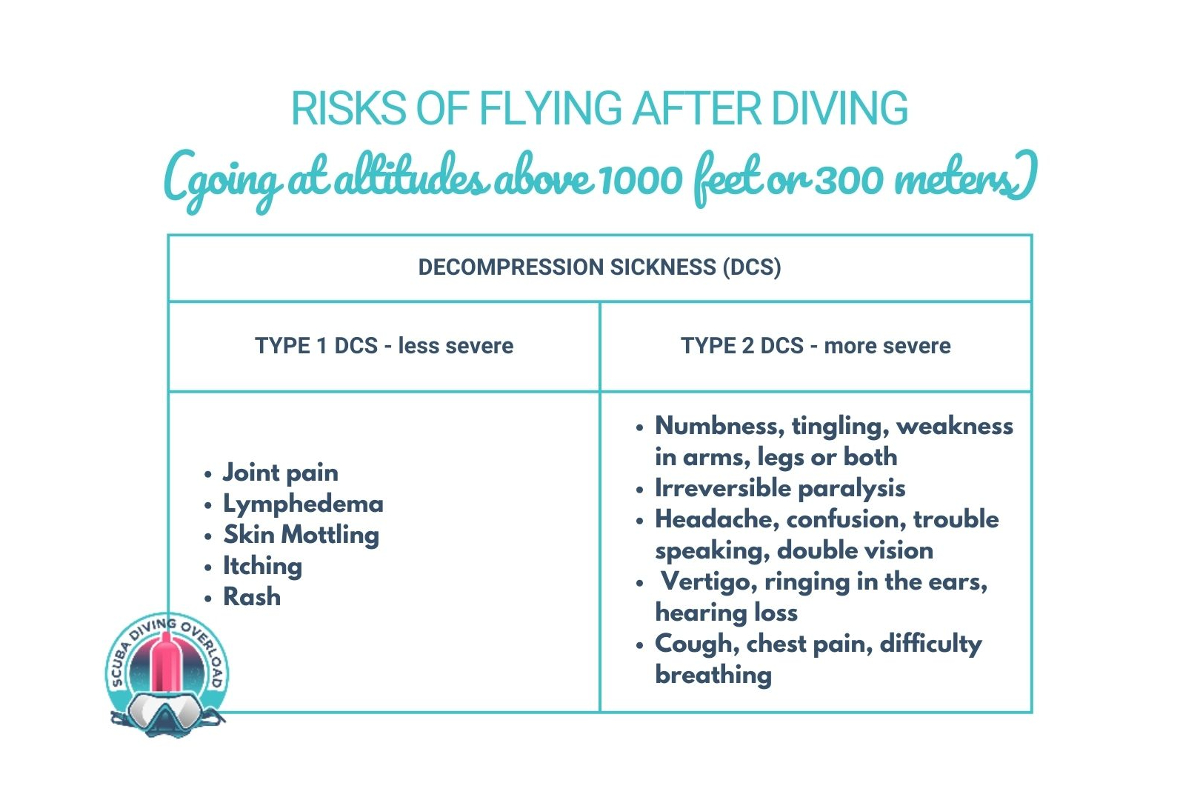
Going on a scuba adventure beneath the surface is exhilarating. But what happens when it’s time to resurface and catch your flight? Flying after scuba diving requires a unique set of considerations to ensure a smooth and safe journey.
Whether you are a newly certified or a seasoned diver reaching new depths, in this post we will go through the fundamental rules of flying after diving. You will understand in greater detail the minimum time that should lapse between your last dive and the time you take a plane or travel at high altitude.
Scuba diving has some fundamental safety rules all divers learn in their open water diver course. Among those, rules related to flying after diving are extremely important. If you don’t follow those rules, you might expose yourself to decompression sickness which can occur even hours after your last dive. To ensure a safe journey after your dive holiday, keep reading to know all the details.
How Much Time Should I Wait Before Taking a Plane After My Last Dive?

As a general rule you should make a 24-hour surface interval before taking a plane. As conservative as it may seem, this ensures that a sufficient amount of time has passed for the residual nitrogen in your body to be expelled, substantially reducing the risk of decompression sickness.
However, in practice, the time lapse between your last dive and the time you board a plane depends on the types of dives you are doing. As you might suspect, the higher the frequency of your dives or the deeper your dives, the higher the level of nitrogen accumulation in your blood. The following table summarizes the minimum surface interval you should conduct for different types of dive profiles, according to the Divers Alert Network (DAN).
| TYPE OF DIVE | MINIMUM SURFACE INTERVAL BEFORE FLYING |
| Single, non repetitive, no decompression | 12 hour |
| Multi-day repetitive dive, no decompression | 18 hour |
| Single or multi day repetitive dive with decompression | substantially more than 18 hour |
These recommendations are the result of 802 trials conducted by the Duke University Center for Hyperbaric Medicine and Environmental Physiology between 1992-1999, together with continuous feedback and reports submitted by divers to DAN. Note that the results of the study were used by the US Navy in 1999 to revise its rules for ascent to altitude following air diving.
In a nutshell, factors affecting your surface interval before flying or going to altitude are your dive profile (recreational vs. technical or decompression dives), your dive intensity (single day vs. multiple days), as well as the gasses used (air or recreational enriched air mix vs. heliox or trimix).
Depending on the Scuba Diving Agency or Scuba Operator you are diving with, these recommendations might vary slightly. In my personal experience, it is always a good practice to remain conservative and wait at least 24 hours before air travel after diving. If you are curious about the guidelines of the different professional diving agencies, I summarize here below their recommendations.
- PADI: Minimum pre-flight surface interval of 12 hours for single dives and 18 hours for repetitive dives. Aligned with DAN.
- SSI: MInimum 12 hours after one dive, and 18 hours after two or more dives. If you went over your no decompression limits or missed a safety stop on the dive, it is advised to wait 24 hours
- NAUI: Minimum24 hours after any dive before flying to altitude.
- SDI/TDI: Minimum 24 hours after your last dive before your scheduled flight.
- DAN: Minimum pre-flight surface interval of 12 hours for single dives and 18 hours for repetitive dives. Aligned with DAN. Substantially more than 18 hours for decompression dives or dives involving the use of heliox or trimix.
- US Air Force: Minimum wait time of 24 hours before flying at altitude.
What Are The Risks of Flying Immediately After Diving?

Flying immediately after diving will expose you to serious or even fatal injuries. To understand the different risks you might incur if you breach the flying after diving recommendations, let’s take a quick look at what happens to your body during a dive and after you ascend. You will learn these basic dive physiology concepts in your open water diver course. For a quick refresher, I suggest also reading this article from the US National Institute of Health.
Diving with compressed gas, whether air, enriched air (nitrox), or other mixes, results in the formation of nitrogen tiny bubbles in your bloodstream. This is because as you descend below sea level, ambient pressure increases, making gasses you breathe more soluble in your bloodstream and body tissues. This is usually not a problem as long as you respect the depth limits of the gas you are breathing and you give enough time to your body to off-gass upon ascending. In particular, if your ascent rate is too fast or if you miss a decompression stop, nitrogen bubbles might form in your bloodstream and body tissues, resulting in decompression sickness (DCS).
The important point to remember, is that even if you conduct a dive respecting all depth limits, decompression stops and controlled ascent rates, you might still have some excess nitrogen bubbles in your tissues and bloodstream. They are, however, simply too small to cause any sign of DCS. Note that this can happen both in technical and recreational diving, even at shallow depths, and no matter the number of dives. If you don’t give your body enough time to expel the residual amount of nitrogen and you travel at altitudes higher than sea level, residual nitrogen bubbles in your body will start expanding as you move at higher altitudes. This will almost certainly cause symptoms of decompression sickness.
Consequently, flying after diving might expose you to decompression sickness, which in turn involves the following risks. Note that severe cases may result in shock and death.
- Joint pain. Typically elbows and shoulders. Pain is deep and boring and does not get worse while moving.
- Lymphedema
- Skin Mottling
- Itching
- Rash
- Spinal cord involvement (numbness, tingling, weakness in arms, legs or both)
- Irreversible paralysis
- Brain Involvement (headache, confusion, trouble speaking, double vision)
- Inner Ear Involvement (vertigo, ringing in the ears, hearing loss)
- Lungs Involvement (cough, chest pain, difficulty breathing)
Given all the possible consequences, it’s definitely not worth exposing yourself to increased risk of DCS. If you are about to book a dive trip, and need to make your time-to-fly calculations, I suggest treating all planned flights equally. No matter if you are traveling on small planes with unpressurized cabins or on a large commercial aircraft with pressurized cabins, to be on the safe side, always plan preflight surface intervals of 24 hours.
Are there other high altitude activities I should avoid after scuba diving?
Although most scuba divers talk about guidelines for flying after diving, the rules apply to all activities that involve going at high altitudes. Whether that’s on a plane, car, train, or walking doesn’t really make much of a difference. DCS risk arises irrespective of the means you use to reach altitudes above 1000 feet (300 meters) above sea level.
Activities that usually involve going at altitudes above 100 feet and that therefore should be avoided 24 hours after diving include:
- Mountain climbing (walking, driving or by train)
- Ziplining as ziplines are usually located in mountainous areas
- Bungee jumping, just like ziplining, this is usually located in mountanous areas
- Parachute jumping
- Paragliding
- Parasailing (although the legal limit in the US is 500 feet, the rope length is usually around 800 feet)
- Skiing or snowboarding
- Air ballooning
- Sky diving
If you are already scuba diving at altitude (above 1000 feet or 300 meters), note that special rules and dive tables apply. If you are diving at altitude and are relying on your dive computer for the time-to fly calculations, make sure you have calibrated it correctly with the appropriate dive height.
Conclusion
Despite different scuba diving agencies recommend different preflight surface intervals, it is always a good idea to stay on the conservative side and plan a 24 hours no-dive time before going at altitude. Whether altitude means flying or going on a hike does not really make a difference, if you don’t respect the preflight surface interval you will expose yourself to the risk of DCS. By observing a 24 hours surface interval, you will give your body plenty of time to off-gass and get rid of residual nitrogen you might have in your body.
Although most of us want to optimize our dive time, particularly while on a scuba holiday, cutting off your pre-flight surface interval is never a good option. Whenever going on a scuba trip, always plan your return flight so that you can have a surface interval of 24 hours.
Other Recommended Articles
- Signs and Symptoms of Decompression Sickness
- How to Overcome Claustrophobia While Diving?
- Can I Scuba Dive While Pregnant?
- Getting Back Into Diving After A Long Break
Flying After Diving FAQs
How much time should I wait before flying if I breach my no decompression limit (NDL) during a recreational dive?
Breaching no decompression limits can happen to most recreational divers. This usually happens in repetitive diving, particularly if you don’t respect your surface interval limits. However, should this happen in a single non repetitive dive, the best course of action is to treat it as if it was a decompression dive and wait 24 hours before flying.
I plan to take my open water diver certificate while on holidays. I am afraid I won’t be able to complete it if i need to wait a minimum preflight surface interval of 24 hours.
I always suggest to plan sufficient time to take any scuba diving course, particularly if you are doing it in a location involving long-distance travel. Most dive operators and instructors suggest a minimum number of days required for each course, but this can change due to different factors. In case you don’t manage to finish a scuba course or certification, you can always ask your instructor to make a referral so that you can finish the course elsewhere.
Can I rely on my dive computer to calculate the minimum preflight surface interval?
You can rely on your computer to calculate your minimum preflight surface interval as long as you have been using the same computer throughout all your dives. You should also get aquainted on the level of conservatism that is being applied by your computer as this can often change.
Does breathing pure oxygen prevent the risk of DCS while flying?
Short answer is yes, breathing 100% oxygen helps reducing risk of DCS while flying. Note however that pure oxygen should be administered by a certified professional and that it should not be used to reduce your preflight surface interval.
Can I scuba dive immediately after flying?
Scuba diving immediately after flying is possible as there is no post-flight minimum surface interval. Although many new divers confuse the two concepts, flying after diving and diving after flying are completely different. You should however be mindful of your physical condition right after a long-distance travel. Diving while jet lagged or tired is never a good option.
Can I fly at low altitudes after scuba diving?
In principle, if your flight is below 1000 feet (300 meters) of altitude, there are no problems. In practice, this is still dangerous and not recommended as even a flight that is planned to stay at low altitudes might breach the 1000 feet threshold in case of unexpected adverse weather conditions.

